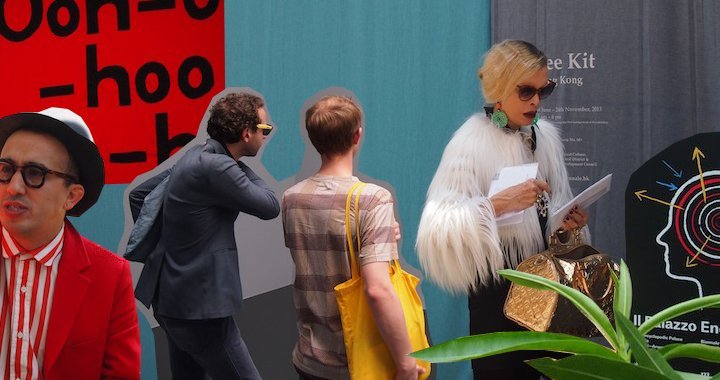
The Year 2013 in Review: Most memorable exhibition?
08/01/2014
Since early December the staff of Arterritory.com has been on a mission to contact the many creative intellectuals from the Baltic States, Scandinavia and Russia in order to discover which exhibition, film, book, disappointment and surprise has created the most memorable impression of the year 2013. Now we can finally reveal all of our findings.
Jana Winderen, Norvegian artist
Soundings: A Contemporary Score, at MoMA, curated by Barbara London. Even if I was part of it myself, I will note is as the most memorable exhibition, and it was very interesting to take part in.
Niekolaas Johannes Lekkerkerk, curator of Tallinn Photomonth 2013
Pierre Huyge's work in Reflections from Damaged Life: An Exhibition on Psychedelia, curated by Lars Bang Larsen, at Raven Row.
Milena Hoegsberg, chief curator at Henie Onstad Kunstsenter, in Høvikodden
In Scandinavia: among others, Hilma af Klint. at Moderna Museet; Hold stenhårdt fast på greia di. Norwegian art and feminism 1968-89, curated by artists Eline Mugaas and Elise Storsveen, at Kunsthall Oslo; and the first Bergen Assembly. I'm leaving so much out.
Pirkko Siitari, director of the Kiasma Museum of Contemporary Art (Finland)
IC-98, at the Turku Art Museum. Their works will be also shown in Kiasma, as part of the Ars Fennica 2014 exhibition.
Kati Kivinen, curator at the Kiasma Museum of Contemporary Art (Finland)
When Attitudes Become Form: Bern 1969/Venice 2013, at Fondazione Prada, Venice; and Ellen Gallagher: AxME, at the Sara Hildén Art Museum in Tampere, Finland.
Suvi Saloniemi, curator at the Helsinki Design museum
It's really hard to say, since no single exhibition was above the rest. I really enjoyed visiting the new Stedelijk, after years of renovation.
Sune Nordgren, Swedish art curator
Cindy Sherman's Untitled Horrors, at the Astrup Fearnley Museum in Oslo, and then later, at the Moderna Museet in Stockholm.
Tanel Veenre, Estonina jewellery artist
The exhibition Irving Penn. Diverse Worlds, at KUMU Art Museum.
Romas Zabaraukas, Lithuanian filmmaker
The Archaeologist’s Collection exhibition by Grisha Bruskin held at the Udarnik movietheater in Moscow.
Marge Monko, Estonian artist
Exhibitions of Gerard Byrne in the Whitechapel and Lisson galleries in London; and Make an effort. Or, failing that, invent, in Bétonsalon, Paris, curated by Aliocha Imhoff & Kantuta Quiros (and which is where I also participated with one of my videos). At the Venice Biennale: Dénes Farkas in the Estonian pavilion, Mark Manders in the Dutch pavilion, and the Lithuanian pavilion.
Mark Raidpere, Estonian artist
The Köler Prize 2013 nominees’ exhibition at EKKM, Tallinn. This does not necessarily mean that it was my favorite one.
Helvijs Savickis, architect, currently studying in Vienna
Unequivocally, the exhibition 2013, by artist Kristaps Ģelzis at the Riga gallery Māksla XO. It was truly powerful and gave a clear message on subjects that, in my opinion, are topical. Works from the show still pop-up in my mind every now and then as I think about how modern painting, with its abstract strokes, is capable of speaking in a clear language. And I didn't consider any geographical boundaries when answering this question.
Ieva Zībarte, Latvian architect
Google Open Gallery, and the virtual exhibitions of the Latvian National Library and other cultural institutions.
Kaspars Zariņš, Latvian painter
From what I've seen, the Venice Art Biennale – as a scene of diversity in art.
Kristīne Kursiša, Latvian artist
Massimiliano Gioni's The Encyclopedic Palace, at the Arsenal; Sanya Kantarovsky's show, You Are Not An Evening, at Gesellschaft für Aktuelle Kunst, in Bremen.
Karlīna Vītoliņa, Latvian photographer
The exhibition Lielviela (MegaMatter), by Latvian artist Miķelis Fišers; Kristaps Ģelzis' show, 2013, was magic! Scott Cambell's tattoos are true works of art.
Ieva Epnere, Latvian artist
It's impossible to answer this question by naming only one exhibition. I must mention Chagall's Between War and Peace, at the Musée du Luxembourg, in Paris; the Morandi exhibition at Bozar, in Brussels; the Ulla Von Brandenburg exhibition at the gallery KIOSK, in Ghent; the just-opened Lucian Freud exhibition at the Kunsthistorisches Museum, in Vienna; and I have a feeling that one of the best shows may be the Pierre Huyghe exhibition at the Centre Pompidou – I'm going to try to go see it.
Dmitry Bulatov, curator of the National Centre for Contemporary Arts (Baltic Branch of NCCA)
Since my specialty is art and the latest technologies, my attention is focused on that kind of exhibitions. In the first place, they are oriented toward creating new facts on the basis of data, the independence of which had remained unnoticed up to then and was not utilized. After that, however, they serve as basis for discovering new relationships between new and old evidence and, correspondingly, forming new concepts. I saw a few innovative works within the framework of the exhibition Yours Synthetically, which took place at Ars Electronica Center; taking into account that the very rhetoric of combining art with synthetic biology is in essence a rebranding of genetic art of the 1990s. Likewise, for a second year running, my attention is drawn by the activities of Microresearch Lab artists and particularly their exhibition workshops that are dedicated to the concepts of re-and de-crystallization. It is an impressive mix on the intersection between media-archaeology, alchemy and paranoia, linked by association to James Graham Ballard and Thomas Pynchon. Essentially, we see by this example of the activities of Microresearch Lab and many other analogous groups of artists, an escalation of DIY-approaches, only brining in new types of media-art practices which previously were rather difficult to combine with each other. This vector is interesting to me and seems promising.
Dmitry Khenkin, co-owner of gallery Тriumph (Moscow)
Nathalie Djurberg and Jan Švankmajer at the Garage.